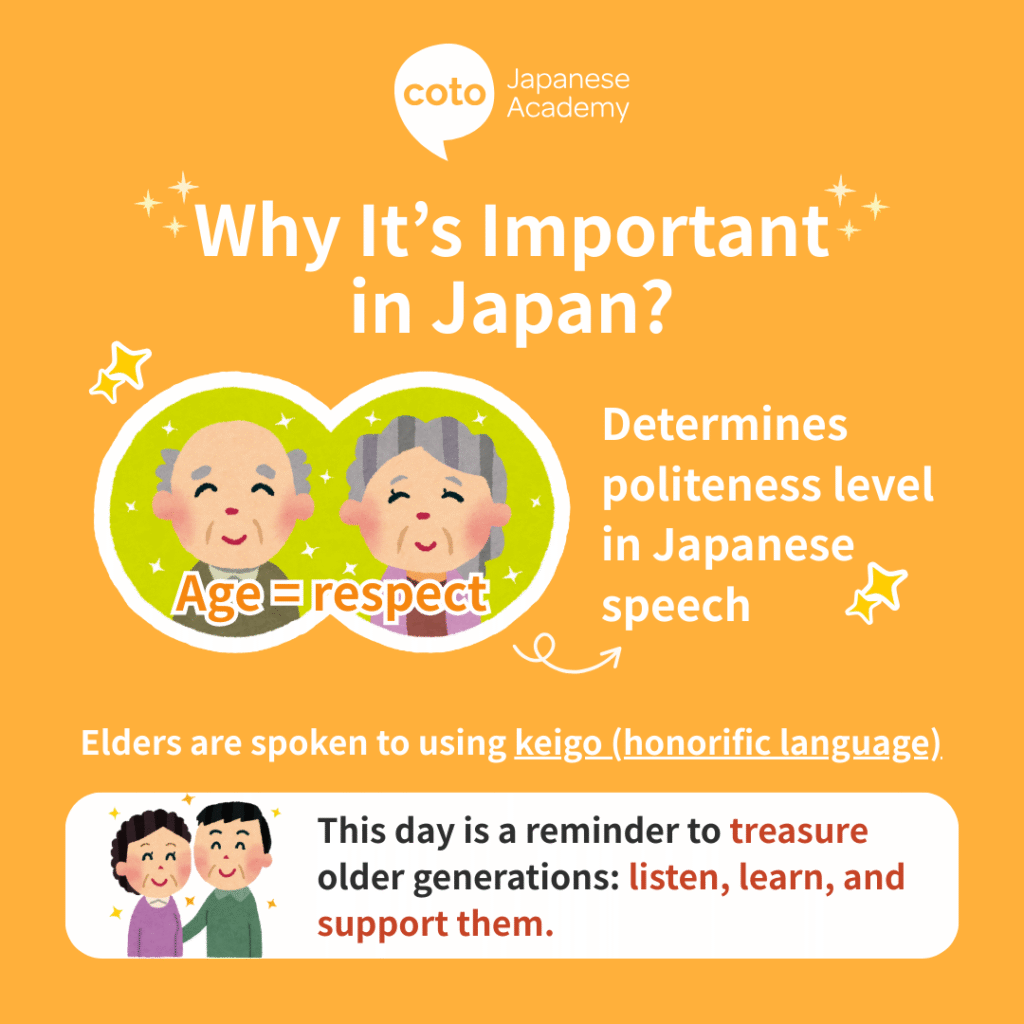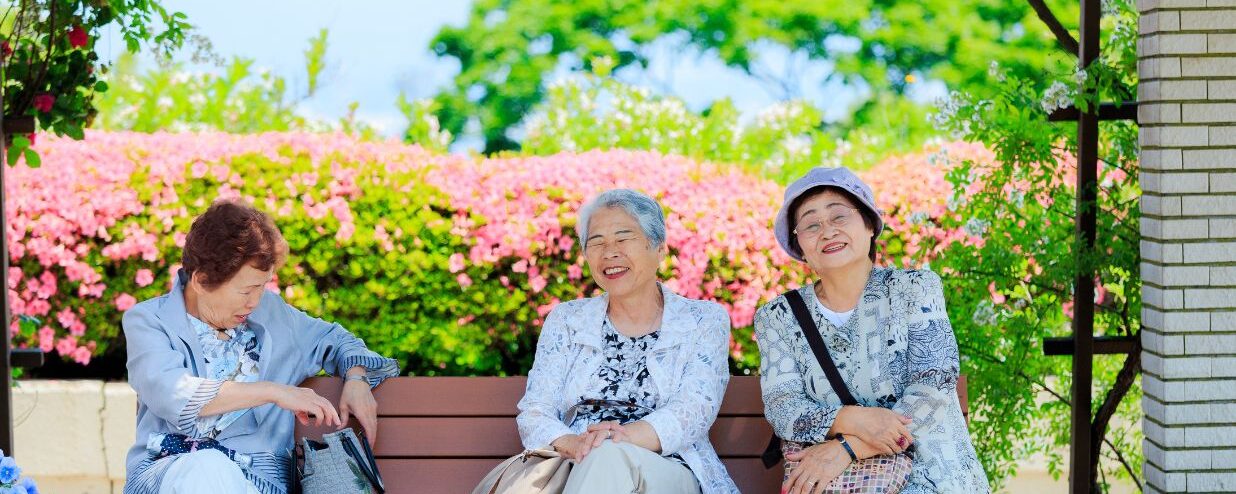What started as a local custom at a village in Hyogo Prefecture, Respect for the Aged Day (Keiro no Hi, 敬老の日) later became a nationwide celebration dedicated to our elders and their countless contributions to society.
Originally called ‘Old Folks Day’, it became a national holiday in 1966, and it occurs on the third Monday of every September. It’s a relatively new holiday compared to many other national ones, and it’s one of the few dedicated to a specific age group, much like Children’s Day in May, meant to celebrate blossoming youth in Japan. In September, when the dates line up just right, Respect for the Aged Day often falls close to the Autumn Equinox, creating a stretch of consecutive holidays known as Silver Week.
So, what is Respect for the Aged Day really about, and how can you join in celebrating Japan’s seniors? Let’s dive in!
Who Does Keiro no Hi Celebrate?

As the name suggests, Respect for the Aged Day is a national Japanese holiday that serves as a time to pause and reflect on how the older generations have paved the way for us. Its Japanese name, 敬老の日 (Keirou no Hi), literally means “day to respect the elderly.” The name itself is made up of three kanji: 敬 (kei), meaning respect and honor; 老 (rou), representing the elderly or aged; and 日 (hi), meaning day.
For those of us who weren’t born and raised in Japan, the cultural differences between Japan and our home country can be many. One thing most of us have probably noticed, though, is Japan’s respect for its elders.
Japan and Palau are the only countries in the world to have national holidays dedicated to the elderly, but the symbolism of this day is relevant to everyone. Most of us, at some point in our lives, will move away from home, and as a result, we see less and less of our parents and grandparents.
There’s no official “starting age” for Keiro no Hi, but these days, turning 60 is generally seen as a bit too young for celebration. Traditionally, someone is considered a silver-haired honoree if they meet at least one of a few milestones: reaching 70 or 80 years of age, having at least one grandchild, or having fully retired from work.
This holiday is a welcome reminder to treasure the older population; to listen to them, learn from them, and support them as much as possible. If you haven’t seen your elderly relatives in a while, simply call them out for lunch and go, “Hisashiburi desu“! It may seem like a small act, but a little does go a long way!
When is Respect for the Aged Day This Year?
Respect for the Aged Day is observed annually on the third Monday of September in Japan, so the exact date varies year by year. Take a look at the table below for the dates from 2025 to 2035!
| Year | Date | Day |
|---|---|---|
| 2025 | September 15 | Monday |
| 2026 | September 21 | Monday |
| 2027 | September 20 | Monday |
| 2028 | September 18 | Monday |
| 2029 | September 17 | Monday |
| 2030 | September 16 | Monday |
| 2031 | September 15 | Monday |
| 2032 | September 20 | Monday |
| 2033 | September 19 | Monday |
| 2034 | September 18 | Monday |
| 2035 | September 17 | Monday |
Why Respect of the Aged Day is Important in Japan

Respect for the Aged Day in Japan is important because it emphasizes respect for older people and serves as a reminder to treasure the wisdom and contributions of the older generation
Japanese society itself really values seniority. How frequently are you asked for your age in Japan? Have you ever been asked your age by a stranger? In other countries, asking someone how old they are could be quite rude. But in Japan, this isn’t meant to offend us. In fact, it is far from it. In most cases, Japanese people ask our age not out of curiosity, but to determine the appropriate level of politeness when speaking to us.
Japanese has three main levels of speech: casual, polite, and honorific. When speaking to someone older, it’s customary to use keigo, the honorific form of the language, to show respect. Age is so important in Japanese society that even being just a year older can make someone your senpai, a term denoting seniority and experience.
This culture, trickled down to its linguistic element — calling someone senpai and using honorific language — reflects the respect Japanese people place on elders and social status in Japan.
Origin of Keiro no Hi
As a national holiday in Japan, Keiro no Hi has a relatively short history. It was originally known as 年寄りの日, or Toshiyori no Hi, which translates to Elderly People’s Day. While it is a descriptive name, it lacked the warmth and respect the holiday intended to convey.
Respect of the Aged Day began locally in Taka Town in Hyogo Prefecture. Back then, it was called Nomaani-mura (“mura” means village) and turned into Yachiyo-cho (town), to Taka-cho, in 1947, just after the end of World War II. The town’s mayor, Masao Kadowaki, encourages people should look up to their elders, specifically those aged 55 and older, for guidance and wisdom. This was also done to celebrate and honor their resilience in surviving two of the most significant tragedies of the 20th century: the worldwide Great Depression and the hardships of World War II.
The holiday gradually gained recognition nationwide, and in 1966, it was renamed Keiro no Hi and officially established as a national holiday. Each year, Japanese media highlight the elderly population, featuring stories about their lives and celebrating the oldest citizens in the country.
How has Keiro no Hi Changed Since It Started?
Respect for the Aged Day was originally observed annually on September 15. However, since that date doesn’t always fall on a weekday, the Japanese government moved the holiday in 2003 under the Happy Monday System to create a three-day weekend. Now, Respect for the Aged Day is celebrated on the third Monday of September, regardless of the actual date, giving people a consistent long weekend to honor the elderly.
After Respect for the Aged Day became more popular, the government decided to give elders a commemorative gift. Originally, in 1963, anyone who turned 100 years old in the previous 12 months received a solid silver sake cup, 10.5 cm in diameter. While this may have seemed extravagant to some, only 153 people qualified for the gift at the time.
Fast forward over 50 years, and Japan now has the largest percentage of centenarians in the world. By 2022, the number of centenarians had grown to more than 90,000, and this trend shows no signs of slowing down. Japan is known for having one of the longest life expectancies in the world, but it also has an aging population, which means the number of elderly people continues to rise. Those aged 65 and above now make up 30% of the population, and by 2055, this figure is expected to reach 40%.
What was once a relatively exclusive gift became much more costly for the government. In 2009, to reduce expenses, the diameter of the cups was decreased from 10.5 cm to 9 cm. Later, in 2016, the material was changed from solid silver to silver-plated nickel alloy.
Jumping forward to over 50 years later, Japan now has the largest percentage of centenarians on the planet – around 30,000. So, rightly or wrongly, in 2016, the government decided to reduce costs by replacing the traditional cups with silver-plated ones.
How is Respect for the Aged Day Celebrated?
There are a few traditional ways to mark this day. First and foremost, with the three-day weekend now available, many people are able to return home to celebrate with their loved ones. Secondly, volunteers in some neighbourhoods help to produce and distribute free bento lunchboxes to older citizens.
Smaller communities also provide various keirokai shows, where teenagers and children perform dances and songs for the elderly. Lastly, the Japanese media take this opportunity to honour our older citizens by featuring special programmes dedicated to them.
There are many other traditions surrounding Respect for the Aged Day, which often vary by community. Individual prefectures across Japan have added their own customs beyond the national 100-year-old silver cup gift. For example, in Kagoshima Prefecture, the city government gives new centenarians a 50,000 yen gift. In a city in Chiba Prefecture, the gift is 30,000 yen, while Tobishima Village in Aichi Prefecture goes even further, offering a 1 million yen gift!
How You Can Commemorate the Day in Japan

Because Respect for the Aged Day is a relatively modern holiday, there are no strict rules for how it should be celebrated. Since it always falls on a Monday, it gives most people a long weekend to organize get-togethers with family and relatives. Here are a few things you can do during Respect for the Aged Day in Japan.
1. Connect with your elders directly
If you’re unable to spend time together in person, then a simple call, letter, or message can go a long way – especially if they aren’t expecting it.
2. Small acts of kindness are contagious
You can be especially kind to older people on this day by offering to carry bags (especially up steps!), holding open doors, and offering your seat on the train or bus.
3. Volunteer
Ask your local community centre if they are running any activities for residents and if you can volunteer. While volunteering in Japan can be challenging due to cultural and language barriers, there are often bilingual staff available to help.
4. Watch one of the Japanese feature programmes about Japan’s older population.
Annually, Japanese media take the opportunity to feature the elderly, reporting on the population and highlighting the oldest people in the country. What better way to learn from our elders? As Mahatma Gandhi said, “Live as if you were to die tomorrow, learn as if you were to live forever.” Our elders possess a wealth of knowledge, and many are more than willing to share it. Why not ask about their experiences with something that matters to you?
Interested in learning more about the Japanese language and culture? Start taking Japanese lessons with us!
One of the best ways to truly appreciate Japanese culture is by learning the language! Now, you can learn Japanese with fun, flexible lessons at Coto Academy, Tokyo and Yokohama’s leading Japanese language school.
Whether you’re interested in intensive courses or part-time lessons, Coto Academy offers small classes of just 8 students, providing professional tutoring from expert native teachers. Immerse yourself in the language and culture while enjoying a personalized learning experience. Ready to get started?
Fill out the form below for a free Japanese level check!
FAQ
What is Respect for the Aged Day?
Respect for the Aged Day (Keiro no Hi) is a Japanese national holiday dedicated to honoring elderly citizens and celebrating their contributions to family, community, and society.
When is Respect for the Aged Day celebrated?
It is observed annually on the third Monday of September, giving people a long weekend to celebrate.
How did Respect for the Aged Day start?
The holiday began as a local celebration called Toshiyori no Hi in 1947 in Taka Town, Hyogo Prefecture. It became a national holiday in 1966 and was renamed Keiro no Hi.
Who is celebrated on this day?
There’s no strict age requirement, but generally, elders who are 70 or 80 years old, have grandchildren, or have fully retired are honored.
How is it celebrated?
Celebrations vary widely. Families often organize get-togethers, give gifts, or spend quality time with elderly relatives. Communities may host events to honor senior citizens.
Is there a special government recognition during Respect of the Aged Day?
Yes! Citizens who reach 100 years old are traditionally honored with a commemorative silver sake cup and a congratulatory letter from the Prime Minister.
Want to learn more about the Japanese national holidays? Read about:
